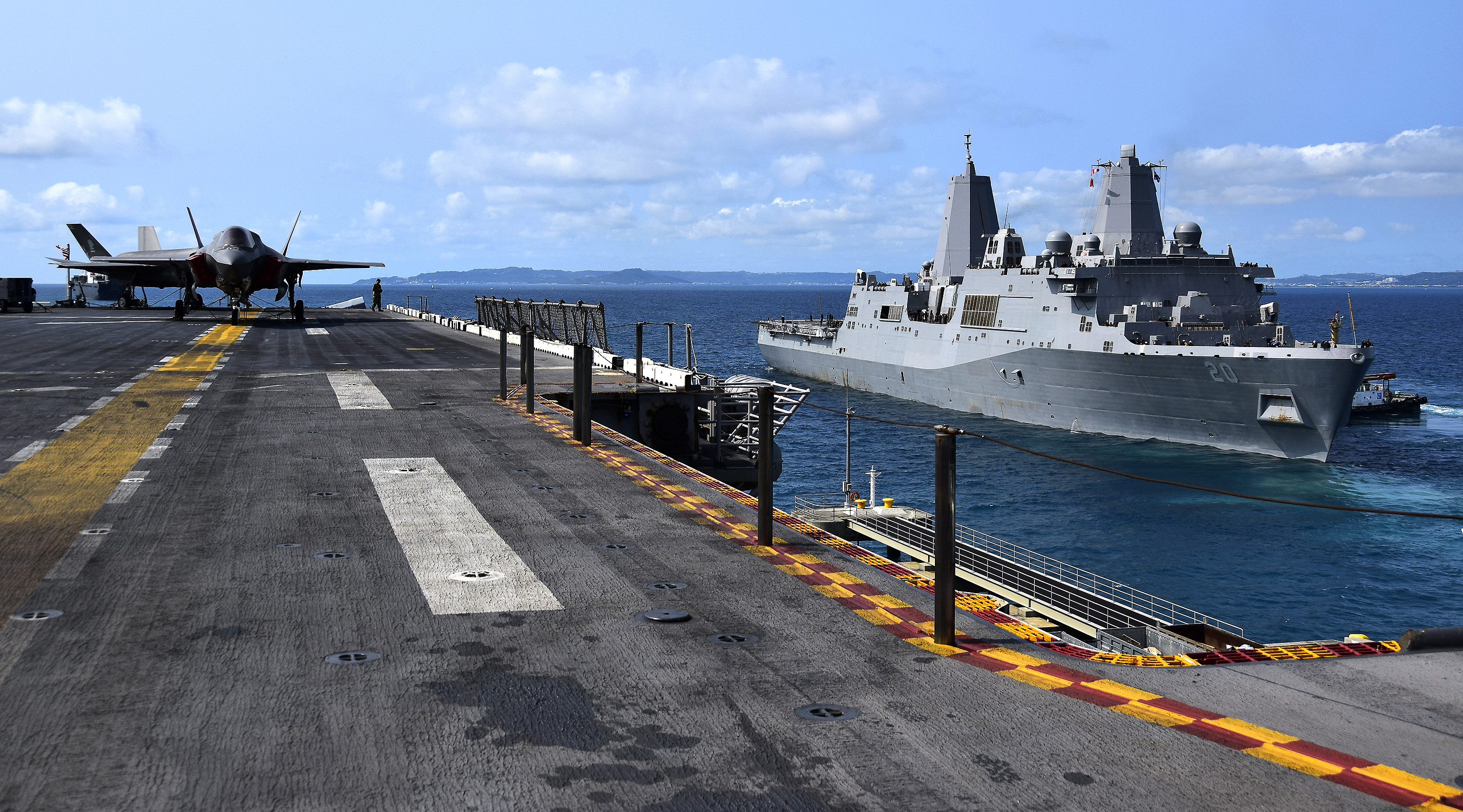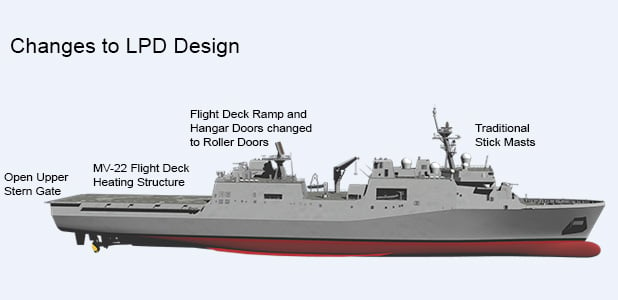
The amphibious transport dock ship USS Green Bay (LPD 20) transits past amphibious assault ship USS Wasp (LHD 1) as the ships depart Okinawa. Green Bay is part of the Wasp Expeditionary Strike Group (ESG), which is operating in the Indo-Pacific region. US Navy photo.
The Navy’s dock landing ship replacement program officially has a name: San Antonio-class LPD Flight II.
In a nod to the high degree of commonality between the Navy’s original LPD design and the variant filling the LX(R) requirement, which replaces the Whidbey Island-class LSD, Navy acquisition chief James Geurts this week signed a memo announcing the LPD Flight II designation.
“The term LX(R) is going to start to go away,” LPD and LX(R) program manager Capt. Brian Metcalf said today at a program briefing at the Navy League’s Sea Air Space 2018 symposium.
“As of yesterday, Secretary Geurts signed a memo that said the LX(R), the requirement for an LX(R), an LSD replacement ship, will be met by LPD Flight II. The first LPD Flight II will be LPD-30,” a hull that lawmakers chose to fund in their Fiscal Year 2018 budget ahead of the Navy’s original plans.
Ultimately, this will create a class of 26 San Antonio hulls – 13 Flight I and 13 Flight II.
Additionally, the Navy is already discussing the possibility of buying the Flight II ships, starting with LPD-31, in a block buy contract. Due to early problems with the San Antonio program – including starting construction before the design was completed, manufacturing quality issues, damage to the shipyard from Hurricane Katrina and instability in the design and the program quantity – the Flight I ships were bought one at a time.
The Navy had planned to stop at LPD-27, but then lawmakers added an LPD-28. And then, once it was determined that the LX(R) design would be based on the LPD design, an LPD-29 was added to help bridge the gap in production between the end of the San Antonio program and the beginning of LX(R). With production ahead of schedule at the Ingalls Shipbuilding yard in Mississippi, lawmakers were considering adding LPD-30 as another bridge ship, but the Navy has instead decided that that hull will be the first of the Flight II ships.

Huntington Ingalls Industries image.
Going forward, Metcalf said “the ideal build rate, according to the shipyard, is one-year centers. Right now the Navy’s program of record does not budget those ships on one-year centers. We have a gap in ‘19 and a gap in ‘21. We are looking to try to answer questions about whether it’s value-added to maybe fill in one or both of those gaps. or if we could execute some kind of block purchase of the follow ships” that would otherwise provide some stability at the shipyard and with Ingalls’ supply base.
He noted that the 2021 ship would be harder to add in – the Columbia-class ballistic-missile submarine will formally start construction in 2021, creating a sizeable bill in the Navy’s shipbuilding account that year, but Metcalf said fielding the ships as quickly as possible is a great priority for the Marine Corps and that conversations would still need to take place about how to achieve the best procurement profile.
Metcalf told USNI News after his presentation that, though there are some differences between the Flight I ships, LPDs 28 and 29 as “transition ships” and the Flight II design, the commonality and subsequent savings in training and logistics were a main selling point for the LPD Flight II concept.
“In my recent trip to San Diego, we could look up and down the waterfront and see five LPDs. Those guys help each other – if somebody has a problem, they’ve got resources down the pipe,” he said.
“So having 26 ships divided around the world allows commonality of parts, commonality of training, sailors that can cross-deck and earn their qualifications. It gives us great flexibility and it saves us from creating a whole other pipeline of accession and training. So it’s been one of the selling points of going to Flight II.”
Asked how much the design changes between Flight I and II would affect the ability to cross-deck sailors, Metcalf said “it’s not going to change the way most of the watches are stood. A couple different capabilities – an EASR (Enterprise Air Surveillance Radar) tech isn’t going to be the same as a 48 (AN/SPS-48G radar) tech, but at the ship operation level, up on the bridge, down in the plant – the engine room is all the same.”
news.usni.org